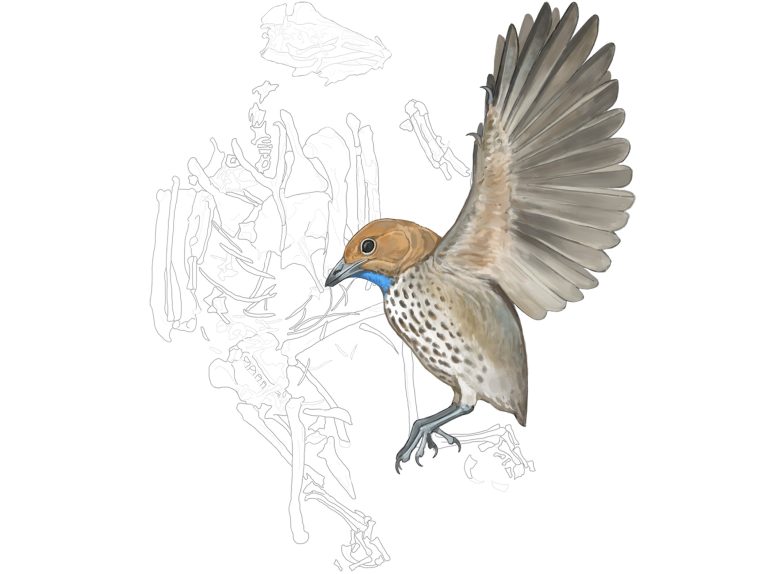
Scientists have discovered a new species of fossil bird, Imparavis attenboroughi which is the first of its kind to have evolved toothlessness. Illustration showing the fossil skeleton of Imparavis attenboroughi, alongside a reconstruction of the bird in life. Credit: Ville Sinkkonen.
No birds alive today have teeth. But that wasn’t always the case– many early fossil birds had beaks full of sharp, tiny teeth. In a paper in the journal Cretaceous Research, scientists have described a new species of fossil bird that was the first of its kind to evolve toothless-ness; its name, in honor of naturalist Sir David Attenborough, means “Attenborough’s strange bird.”
“It is a great honor to have one’s name attached to a fossil, particularly one as spectacular and important as this. It seems the history of birds is more complex than we knew,” says Sir David Attenborough.
All birds are dinosaurs, but not all dinosaurs fall into the specialized type of dinosaurs known as birds, sort of like how all squares are rectangles, but not all rectangles are squares. The newly described Imparavis attenboroughi is a bird, and therefore, also a dinosaur.
An Unusual Discovery
Imparavis attenboroughi was a member of a group of birds called enantiornithines, or “opposite birds,” named for a feature in their shoulder joints that is “opposite” from what’s seen in modern birds. Enantiornithines were once the most diverse group of birds, but they went extinct 66 million years ago following the meteor impact that killed most of the dinosaurs. Scientists are still working to figure out why the enantiornithines went extinct and the ornithuromorphs, the group that gave rise to modern birds, survived.
“Enantiornithines are very weird. Most of them had teeth and still had clawed digits. If you were to go back in time 120 million years in northeastern China and walk around, you might have seen something that looked like a robin or a cardinal, but then it would open its mouth, and it would be filled with teeth, and it would raise its wing, and you would realize that it had little fingers,” says Alex Clark, a Ph.D. student at the University of Chicago and the Field Museum and the paper’s corresponding author.
But “Attenborough’s strange bird” bucked this trend. “Scientists previously thought that the first record of toothlessness in this group was about 72 million years ago, in the late Cretaceous. This little guy, Imparavis, pushes that back by about 48 to 50 million years. So toothlessness, or edentulism, evolved much earlier in this group than we thought,” says Clark.
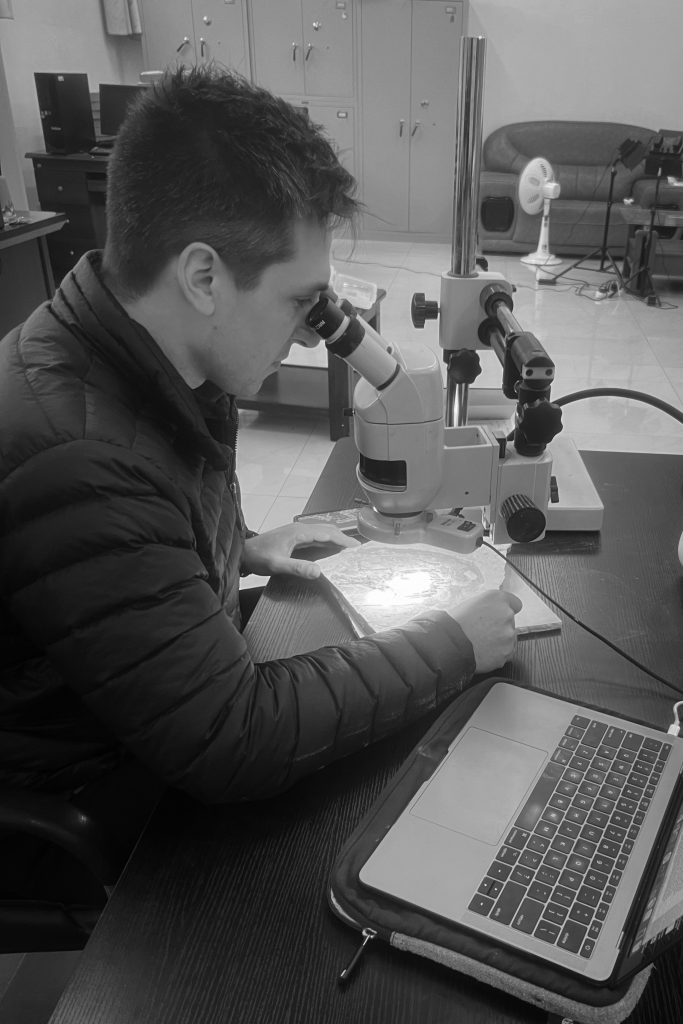
Alex Clark, a Ph.D. student at the Field Museum and the University of Chicago, examining the fossil he helped describe, Imparavis attenboroughi. Credit: Courtesy of Alex Clark
The specimen was found by an amateur fossil collector near the village of Toudaoyingzi in northeastern China and donated to the Shandong Tianyu Museum of Nature. Clark’s advisor and co-author on the paper, Field Museum associate curator of fossil reptiles Jingmai O’Connor, first noticed something unusual about this fossil several years ago, when she was visiting the Shandong Tianyu Museum’s collections.
“I think what drew me to the specimen wasn’t its lack of teeth– it was its forelimbs,” says O’Connor. “It had a giant bicipital crest– a bony process jutting out at the top of the upper arm bone, where muscles attach. I’d seen crests like that in Late Cretaceous birds, but not in the Early Cretaceous like this one. That’s when I first suspected it might be a new species.”
O’Connor, Clark, and their coauthors in China, Xiaoli Wang, Xiangyu Zhang, Xing Wang, Xiaoting Zheng, and Zhonghe Zhou, undertook further study of the specimen and determined that it did indeed represent an animal new to science.
Insights into Flight and Diet
The unusual wing bones could have allowed for muscle attachments that let this bird flap its wings with extra power. “We’re potentially looking at really strong wing beats. Some features of the bones resemble those of modern birds like puffins or murres, which can flap crazy fast, or quails and pheasants, which are stout little birds but produce enough power to launch nearly vertically at a moment’s notice when threatened,” says Clark.
Meanwhile, the bird’s toothless beak doesn’t necessarily tell scientists what it was eating, since modern toothless birds have a wide variety of diets. Like its fellow enantiornithines, and unlike modern birds, it does not appear to have a digestive organ called a gizzard, or gastric mill, that helped it crush up its food.
While Clark notes that “an animal is more than the sum of its parts, and we can’t fully know what an animal’s life was like just by looking at single components of its body,” he and his coauthors have been able to hypothesize about some of Imparavis’s behavior and ecology, based on the details of its wings, feet, and beak together. “I like to think of these guys kind of acting like modern robins. They can perch in trees just fine, but for the most part, you see them foraging on the ground, hopping around and walking,” says Clark.
“It seems like most enantiornithines were pretty arboreal, but the differences in the forelimb structure of Imparavis suggests that even though it’s still probably lived in the trees, it maybe ventured down to the ground to feed, and that might mean it had a unique diet compared to other enantiornithines, which also might explain why it lost its teeth,” says O’Connor.
Understanding Evolution and Extinction
In the paper, the researchers also revisited a previously described fossil bird, Chiappeavis (which O’Connor named eight years ago after her Ph.D. advisor), and suggest that it too was an early toothless enantiornithine. This finding, along with Imparavis, indicates that toothlessness may not have been quite as unique in Early Cretaceous enantiornithines as previously thought.
Clark said that nature documentaries by Sir David Attenborough, in which the renowned British naturalist narrates the behavior of different animals, were pivotal to his own interest in science. “I most likely wouldn’t be in the natural sciences if it weren’t for David Attenborough’s documentaries,” says Clark, explaining why he chose to name the new fossil after Attenborough.
Clark and O’Connor noted the importance of Attenborough’s messaging that not only celebrates life on earth, but also warns against the mass extinction the planet is undergoing due to human-caused climate change and habitat destruction.
“Learning about enantiornithines like Imparavis attenboroughi helps us understand why they went extinct and why modern birds survived, which is really important for understanding the sixth mass extinction that we’re in now,” says O’Connor. “The biggest crisis humanity is facing is the sixth mass extinction, and paleontology provides the only evidence we have for how organisms respond to environmental changes and how animals respond to the stress of other organisms going extinct.”
Reference: “First Edentulous Enantiornithine (Aves: Ornithothoraces) from the Lower Cretaceous Jehol Avifauna” by Xiaoli Wang, Alexander D. Clark, Jingmai K. O’Connor, Xiangyu Zhang, Xing Wang, Xiaoting Zheng and Zhonghe Zhou, 27 February 2024, Cretaceous Research.
DOI: 10.1016/j.cretres.2024.105867



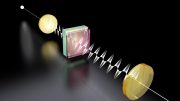
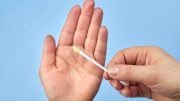

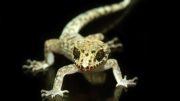
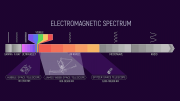
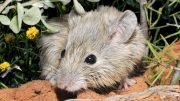
Pseodoscience again Jurassic park science and propaganda .birds are not thecodont .thecodont is crocodilian like dinosaur allways can call dinosaur crocodilian it is still call crocodilian in scientific world they are many type of crocodilian like cats. today crocodilian is different type crocodilian than most dinosaur only one dinosaur can call like today crocodilian spinosauridae the mesoeucrocodylia dinosaur the death roll system dinosaur
Is it pseudoscience.they are no flying crocodilian they are no evidence or flying reptiles. pterosaur is a dinosaur that can not fly it’s a very aquatic dinosaur that has whale nose heavy horn and giant skull worst feature for flight pterosaur clearly is a dinosaur serrated teeth and dinosaur ankle pygostyle tail I would not be shock of flying crocodilian because crocodilian are so advance but they are no evidence to support that.pterosaur is very primitive dinosaur like eoraptor that have palate teeth like today tuatara reptiles the ancestor gator and lizard
Pseudosuchus is archosaur not a archosauriformies the pseudosuchus are dinosaur that are not ancestor of modern crocodilian only spinosauridae is.pseudosuchus does not have primitive palate teeth that why it’s archosaur it has wider skull found in tetanuran dinosaur like the gator compsognathus. Ceratosaurus dinosaur the bird velociraptor and oviraptor bird have a bird skull that lack fenestra the hole in skull .t.rex gator have the most fenestra in the skull in dinosaur it reach the mammal count
Pterosaur and eoraptor most of teeth are thecodont the crocodilian teeth the tuatara teeth are remnants the tuatara teeth of eoraptor are links between crocodilian and tuatara .tuatara have overlapping scale like lizard not found in gator and turtle that have the same skin .in tuatara reptiles it is not found in fossil tuatara kind so they are not link to lizard . fossil turtle had teeth the same teeth has tuatara and fish the teeth fuse to skull no gum technology .so turtle is crocodilian type of reptile but it is not a thecodont because it has crocodilian skin protothecodont
Today tuatara skin is like lizard but fossil kind has different skin not link to gator or lizard .the search for dinosaur was over for long time clearly modern crocodilian is last living dinosaur and greatest dinosaur ever the most dangerous dinosaur ever .jurassic park film will never change that even hype would not change that gator are alive the best evidence the jurrasic park good film bad science it’s pseudoscience .badit scientist its over you will never win stop wasting time and get with the program
The evidence information that gator is a dinosaur easy find free on the internet .the badit mainstream news media is not your Allie when expose they will not be on your side so stop cover up and hide evidence and hype up real dinosaur the gator .mainsteam news media believe they are not a tabloid they mite do real journalism.imparavis has teeth were is hype these teeth are same teeth as archaeopteryx and oviraptor ancestor teeth . These teeth are not thecodont some how this story has a link to dinosaur .why no story show irritator mandibular bones are fuse some bone they did not talk the other bone probaly all bone are fuse like today dinosaur the gator I did not read that part any bone fuse in lower jaw it is mesoeucrocodylia
It clearly says these mandibular bone are fuse irritator is a gator.the link.the osteology of irritator.paleo electronica org.no link here dinosaur are primitive they have serrated teeth they could not crush bone it’s rip off flesh not bone then prey animal died advance dinosaur gator t.rex can crush bone peg teeth the solid lower jaw like advance mammal but ziphodont serrated teeth did return in mesoeucrocodylia you can see dinosaur are primitive weak bite force they lack a full palate that why the invent ziphodont serrated teeth like primitive lizard monitor lizard . Modern crocodilian is technology marvel it is won of the most advance animal alive today
”No birds alive today have teeth” => Authors, please familiarize yourselves with geese, penguins, bowerbirds, toucans and toucanetes, and their anatomy.
Those are not teeth its a beak shape like teeth .skull bone were teeth are bird has small skull bird is advance animal that have gums there teeth are advance more advance than dinosaurs it’s not a deep root teeth these teeth are found some lizard .lizard has 2 type of teeth one simular to dinosaur and one simular to birds .bird skull get smaller because of flight to save weight the modern bird the fossil bird like archaeopteryx velociraptor has long snout that make them look like dinosaur the modern bird look nothing like dinosaur the beak is not skull bone.i only saw geese humming bird fake teeth the beak is like claws not bone
The premaxllary must fuse to have a beak bird has thin snout there need a strong skull because wing are not use for hunting it’s very rare in animal that why confusetion when they found spinosauridae they said it was maniraptoran it’s because of fuse premaxillary it’s convergent evolution this is because death roll system and thin snout the high torsion it’s rare in dinosaur because only spinosauridae has a death roll system bird hip dinosaur allso is fuse they have a beak. Beak are not really a good predator feature that why most dinosaur does not have it there skull are same as tuatara ancestor .gator are advance animal and predator that need a strong skull so it does not break when doing death roll that why premaxllary is fuse that why spinosauridae is a mesoeucrocodylia
Spinosauridae is unique predator easy to tell it is mesoeucrocodylia because of hunting style and feature demand .velociraptor bird and oviraptor bird and archaeopteryx bird are not missing bone in the skull as say it’s reptile skull the modern bird are wons that missing bone they have bigger brain and lighter skull for flight they do not need strong skull for predator the flight is better to escape predator
Archaeopteryx bird velociraptor bird oviraptor bird lack a flight skull the reason they say oviraptor is true ancestor of modern bird and not archaeopteryx because the skull is simular to modern bird the snout is small a flight feature clearly it is a flightless bird other simular fossil bird like oviraptor same small snout and high skull for the bigger brain .oviraptor allso the premaxllary are fuse .archaeopteryx the premaxllary are not fuse no beak.velociraptor does not have a beak no fuse premaxllary .oviraptor is beak bird with plant eating beak only plant eating in tetanuran is mesoeucrocodylia likey do to full palate a evolution advitage
Spinosauridae clearly is very primitive the palatine are not fuse like early gator type mesoeucrocodylia the pterygoid is fuse thou protosuchus sphenosuchus it is not fuse in some birds palatine pterygoid are fuse in bird hip dinosaur some are fuse the pterygoid the primitive dinosaur clearly show how they turn into the greatest dinosaur ever the modern crocodilian because mammal has a full palate the snout is very diverse same evolution conclusion for modern crocodilian these are very successful animal today
No evidence of flying reptile like birds gliders do not count some reptile of today are gliders